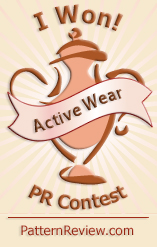 |
| Marked up ineptly in Skitch |
The yellow outlines are the cup pattern pieces for Harriet. The pink outlines my TNT cup pattern. There are two things that occur to me.
- The shape at the bottom is very different.
- The "dart" at the top is very different.
Bottom Edge
The lower edge of the Harriet cup is relatively flat (black arrow) whereas my TNT pattern has quite a curve (red arrow). Harriet curves up, but only a bit, at the seam between the lower cup and the upper cup. My TNT pattern curves deeply and smoothly throughout the entire bottom line of the cup.
Dart
When I say "dart", I mean the space between the top edge of the lower cup piece and the bottom edge of the top cup piece.
To assist, I marked the ends of the dart on the Harriet pattern with orange exclamation markers (the marker should actually point at the little dot on the upper edge of the lower cup) and those on the TNT pattern with green check mark markers.
Imagine the two marked shapes sewn together in three dimensions. We have a lightly darted cup with a lot of curve in the lower edge of the cup (TNT) and a deeply darted cup with a relatively flat lower edge (Harriet).
What is the effect of these differences?
 |
| Harriet cup projection - side view |
 |
| Harriet cup projection - view from the bottom of the band |
By contrast, when the already-curved edge of the TNT cup is sewn into the same frame shape, it is not forced upward at a right angle, but rather forms a slope. The highest point of the cup is lower (less of a dart) and the continuous curve of the dart means that the shape of the cup is less pointy.
I prefer to get my roundness from the support of a flatter lower cup sewn in stretch fabric than from the pre-defined projection of a cup sewn in fabric with low or no stretch. Lucky for me, I'm small enough that the former works.
Therefore, my next trick is either going to be a mash-up or something completely different, to cleanse my sewing palate.



This was very illuminating -- and illustrates beautifully why so many women get frustrated at finding a bra that fits. Thank you for taking the time to write about your bra project. It has proved useful to me, at the very least.
ReplyDeleteThank you so much for the in depth investigation! This appeals to my inner geek! Love the overlay on the window. Definitely an aha moment. I'm ramping up to make my first bra which I swore I would never do but like everything else over the years I've become more picky about fit.
ReplyDeleteAny bra beginner advice? Any pattern suggestion for a bralette for AA cup? Jalie looks like it might work but it seems like everyone has a bra pattern these days.
Why are you looking to new bra patterns when you already have a TNT?
I am so happy to see all these little details. I noticed on an earlier lingerie post of yours, someone recommended the A Bra That Fits subreddit -- they not only have all these kinds of details around shapes, but they've given them all useful names too.
ReplyDelete